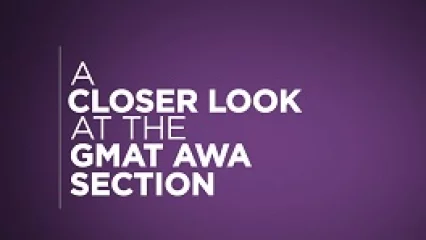Helpful for: GMAT Test Takers
Read Time: 10 minutes
Quick Facts:
• Although the AWA essay prompts change each time, the directions for the task are always the same. Memorize them. Simply put, your job is to write a critique of the given argument.
• Each AWA argument will have flaws. These flaws may include: assumptions, insufficient evidence, statistic issues, vague words like “many” or “few,” unfitting comparisons, overlooked information.
• Your essay should be a focused and in-depth analysis that exposes these flaws, and suggest ways to fix them or strengthen the validity argument.
• Avoid stating whether you agree or disagree with the argument. Stick to the fact that the argument is always flawed.
• Top-scoring essays follow a simple structure. You shouldn’t try and be creative as you have the chance of getting off course. Using a GMAT essay template and practicing writing essays with it will help you write clearly and address each flaw convincingly.
• There are many GMAT essay templates you can search for online, until you find the one that works best for you. The template offered by GMAC, GMAT Write gives you 2 essay prompts and 4 essay submissions. The tool scores you using the official GMAT scoring algorithm and costs $29.99
• After reviewing several essay templates, you also have the option of creating your own.
• If you choose to create your own template, start by choosing an existing one that you’re comfortable with, or a combination of elements from a few different ones. Afterwards, write an essay with each template using different prompts.
• Next, you should grade your own essays. Write detailed comments on what you think is done well and what isn’t. Reading the essays out loud will help you notice things easier and evaluate their flow. Perhaps you realize that the flaws are too spread out, or maybe the introduction is way too long and should be more straight-forward.
• Once you review the comments of your essays, you should be able to create a template of your own. Make sure to include some sentence starters and transition words that you can reuse. Practice writing two essays with your final template to see its effectiveness. Remember to be flexible, use your template as a guide but vary your wording in each essay.
Useful Information:
• Plagiarism is a serious offence, and will most likely get you disqualified. GMAT readers are experts and will realize a text or idea that is not your own right away. PrepScholar explains:
Selected Quote:
It’s totally okay to use a GMAT essay template, and it’s even okay to create those sentence stems for preemptively constructing your critique—what’s not okay is using the exact wording or specific ideas that were written by another person. For example, you can use the “summarize the issue, acknowledge the author’s point, and state your thesis about how the argument is flawed” template for your introduction, but you shouldn’t use the sentence that I gave you illustrating this thesis in action (“Though this argument is compelling at face value, its conclusion is ultimately untenable because it rests on ______ “). The same goes for anything you’ve read online or in a test prep book: while it’s a great idea to Google and read other essays on the practice prompts that you find challenging during your prep, you shouldn’t use anyone else’s words if you encounter such a prompt on test day. In short, everything you write has to be your own words, but they can be your own words that you yourself came up with beforehand.
Source: PrepScholar



